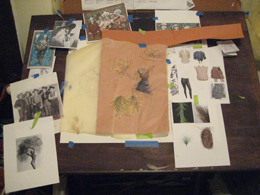
To figure out which designer to interview for this piece, I solicited suggestions from a few friends with the following direction: "I want a rad lady designer." Costume Designer Debbie Baer came up more than once. After setting up our meeting, I mentioned it to a few theatre-industry friends - I couldn't believe how many of them knew and loved her - and none of them could believe I didn't know her.
Like most designers I've met, Debbie's path hasn't exactly been linear. An English Literature major with a strong interest in fashion, she used her summers to keep one foot in the fashion industry in a pretty serious way. During her undergraduate years, she attended a summer design intensive at Parsons and worked for renowned designers Isaac Mizrahi and Jacques Fath. "I learned a lot from Isaac about process. One of my charges as his intern was to scour the city for inspiration...He was obsessed with mylar that season so I went through New York - it was crazy - I went through New York looking for silvery shiny things that might relate to his mylar. He couldn't pinpoint 'why mylar'...His studio was a loft space in Soho and you exit the elevator and you're already in the office - and I remember him one day getting off the elevator and announcing to the whole office: 'MYLAR. IT IS MYLAR.' And he went straight into his studio." Flamboyance and absurdity aside, there was a lesson to be learned: "...inspiration can come from lots of things. He really had me go everywhere to find anything that looked cool. And to see how that translates into a collection, into a design - that was the biggest thing I took from that experience."
 So how did she make the transition from fashion assistant to costume designer? Like many of us, Debbie found herself back home after college, not really sure what to do next. After stumbling on Steppenwolf's intern program, she figured that the costume shop was a good place to start. "My undergraduate thesis was on Beckett and I concentrated a lot on modern European drama...[so I thought], I know a lot about drama, and I know a lot about clothes - maybe they'll hire me. And they did, and I quickly got my first design job without having ever designed a show, or really having any qualifications... So I just figured it out as I went, and then refined my skills in Grad School."
So how did she make the transition from fashion assistant to costume designer? Like many of us, Debbie found herself back home after college, not really sure what to do next. After stumbling on Steppenwolf's intern program, she figured that the costume shop was a good place to start. "My undergraduate thesis was on Beckett and I concentrated a lot on modern European drama...[so I thought], I know a lot about drama, and I know a lot about clothes - maybe they'll hire me. And they did, and I quickly got my first design job without having ever designed a show, or really having any qualifications... So I just figured it out as I went, and then refined my skills in Grad School."
With a few years of designing under her belt, Debbie headed to Northwestern for her MFA - her peers included directors and designers with whom she continues to work - and that's no accident. "I think what's common in our vocabulary is how we approach a play - the collaborative way that we approach things...I think that's why when you see shows of ours together, they work. I wouldn't say that they're always coming from the same aesthetic direction. I think we have shared the same process of really talking through the play with the design team, really being comfortable blurring the lines... maybe the best costume idea's coming from [the lighting designer], or maybe I'm saying, 'wouldn't it be great if this was a really warm light' - I think we all sit at the table and talk in the same way."
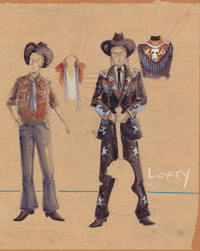 Unsurprisingly, the words "collaboration" and "community" kept resurfacing throughout our conversation, both in reference to Debbie's process and the projects to which she attaches herself. "I'm really good at building on the idea on the table. I really trust and rely a lot on the directors I work with, and for that reason, I really look for their direction for that first thing. And what I bring to it could be totally different than that, but it's always a reaction to what the director's bringing me. I really work well in a volleying sort of thing." I asked her to talk more specifically about her relationship with director/choreographer Tommy Rapley, with whom Debbie frequently collaborates. Their work together was last seen in House Theatre's All The Fame Of Lofty Deeds.
Unsurprisingly, the words "collaboration" and "community" kept resurfacing throughout our conversation, both in reference to Debbie's process and the projects to which she attaches herself. "I'm really good at building on the idea on the table. I really trust and rely a lot on the directors I work with, and for that reason, I really look for their direction for that first thing. And what I bring to it could be totally different than that, but it's always a reaction to what the director's bringing me. I really work well in a volleying sort of thing." I asked her to talk more specifically about her relationship with director/choreographer Tommy Rapley, with whom Debbie frequently collaborates. Their work together was last seen in House Theatre's All The Fame Of Lofty Deeds.
"[Tommy and I] work really well together because we share a similar aesthetic...And we have a common vocabulary of visual storytelling - we think the same visual things mean the same thing...I like the movement focus of his pieces - I'm really interested in designing for dance - I'm interested in the visual vocabulary of movement, and Tommy does beautiful work with movement. And I like that he has really good taste, and he really knows what he's talking about, when he talks about design. And I respect that and I feel like we can have just a good conversation. I feel like we're on equal footing and just kind of go places together. And I think that that's the case with the directors who ask me back."
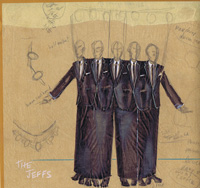 It's obviously important for a designer and director's vision to mesh - and that also includes agreeing to edit when necessary. Looking through Debbie's renderings for Lofty Deeds, I noticed that 'the Jeffs' began with a different concept than what was presented onstage. Originally designed as a seven-headed monster of sorts, 'the Jeffs' are essentially a machine of corporate record executives, menacing but calm. However, late in the fitting process, it was clear that the unisuit was not serving its intended purpose. Debbie suggested scrapping the idea, and after some thought, Tommy agreed. "It was liberating, because it was going to be an obstacle to the storytelling, as opposed to support." 'The Jeffs' became seven separate people acting as one unit.
It's obviously important for a designer and director's vision to mesh - and that also includes agreeing to edit when necessary. Looking through Debbie's renderings for Lofty Deeds, I noticed that 'the Jeffs' began with a different concept than what was presented onstage. Originally designed as a seven-headed monster of sorts, 'the Jeffs' are essentially a machine of corporate record executives, menacing but calm. However, late in the fitting process, it was clear that the unisuit was not serving its intended purpose. Debbie suggested scrapping the idea, and after some thought, Tommy agreed. "It was liberating, because it was going to be an obstacle to the storytelling, as opposed to support." 'The Jeffs' became seven separate people acting as one unit.
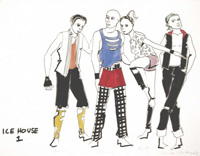 To work with Debbie, it seems, is to believe in the value of experimentation. "To really play with someone, honestly, you need to really trust the group." Another frequent collaborator is Collette Pollard, a set designer with whom Debbie has begun to develop a "signature aesthetic," which she discusses a bit on her blog. "I do approach my work with a sense of play and a sense of humor, and I delight in visual play." She describes her work with Collette as a "really good balance - she brings out the elegant lines and she brings that out in me, and I bring out the playfulness...But I think my successful designs are the ones that balance that with elegance - no matter what it has to support the story and look good."
To work with Debbie, it seems, is to believe in the value of experimentation. "To really play with someone, honestly, you need to really trust the group." Another frequent collaborator is Collette Pollard, a set designer with whom Debbie has begun to develop a "signature aesthetic," which she discusses a bit on her blog. "I do approach my work with a sense of play and a sense of humor, and I delight in visual play." She describes her work with Collette as a "really good balance - she brings out the elegant lines and she brings that out in me, and I bring out the playfulness...But I think my successful designs are the ones that balance that with elegance - no matter what it has to support the story and look good."
Given her working style, it makes sense that Debbie often finds herself designing for new scripts. "I think it goes back to that whole spirit of collaboration - when you're working with a play that is not fully formed, I feel like you have more of an entry into the material, in a way. And I think it challenges you to be bold...With a new work it's a lot more from your gut." But that doesn't mean total abstraction. "I always go to book research first. I feel like it lets me focus in a way that internet research doesn't...Sometimes I'll start [with the internet] to find a cool image and then I'll try to assess from that image what I'm looking for."
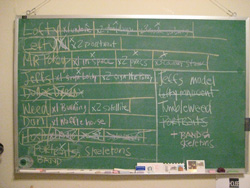 And then, there's the chalkboard. "This is so dorky. I like how chalk feels. I like writing in chalk. And if it's on my wall, I can't lose it. And if it's big I can't miss it or ignore it. It's totally practical...it's definitely like a ritual - I write the character names, and then when they get a sketch they get an X, and when they get colored in, they get a check...it focuses me a little bit. And it's way more fun than just writing a list on paper...there's just something so immediate about it - I can very quickly alter it...and it's fun."
And then, there's the chalkboard. "This is so dorky. I like how chalk feels. I like writing in chalk. And if it's on my wall, I can't lose it. And if it's big I can't miss it or ignore it. It's totally practical...it's definitely like a ritual - I write the character names, and then when they get a sketch they get an X, and when they get colored in, they get a check...it focuses me a little bit. And it's way more fun than just writing a list on paper...there's just something so immediate about it - I can very quickly alter it...and it's fun."
So what's on the chalkboard these days? Debbie is currently designing The Wiz for First Stage Children's Theatre in Milwaukee, as well as an as-yet-untitled show for Albany Park Theater Project. In the future, she'd like to try her hand at designing for dance - but for now, between travelling back and forth to Milwaukee and dressing 28 sixteen year-olds for Albany Park, her plate is on the full side.
Julienne Bilker

 Follow Us On Twitter
Follow Us On Twitter